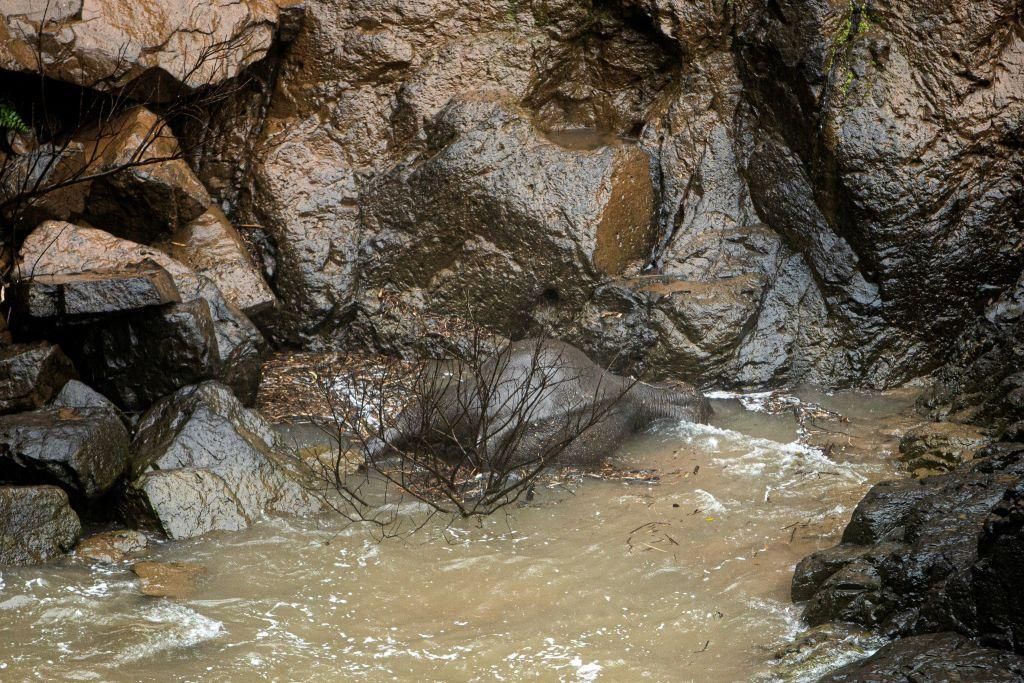Six Elephants Die After Plummeting Down a Waterfall in Thailand
It is believed that five adults lost their lives while trying to save a calf
/https://tf-cmsv2-smithsonianmag-media.s3.amazonaws.com/filer/cd/3a/cd3ad01d-a67c-4440-b966-5108b34659fa/two_surviving_thai_elephants.jpg)
In the early hours of Saturday morning, rangers at the Khao Yai National Park in Thailand heard loud elephant calls coming from a ravine. When they arrived to investigate, as Richard C. Paddock and Muktita Suhartono of the New York Times report, the rangers discovered a grim scene: six dead elephants, seemingly killed by a raging waterfall known as Haew Narok—or “Hell’s Abyss.”
No one witnessed the incident, but track patterns at the site, along with elephants’ known tendency to form close social bonds, lead park officials to believe that a calf fell over the waterfall and five adults died while trying to save it. This is not, in fact, the first time that such a tragedy has occurred at Haew Narok; in 1992, according to the BBC, a herd of eight elephants plunged to their deaths there.
The national park had previously erected fencing around Samor Poon Creek near the waterfall, but “it was not sufficient in this case,” Paddock and Suhartono write.
Two members of the herd were discovered alive on a cliff overlooking the waterfall, reports Li Cohen of CBS News. The surviving elephants had trumpeted the distress calls that alerted rangers to the deaths; they appeared exhausted, and were struggling to climb out of the ravine. Edwin Wiek, founder of Wildlife Friends Foundation Thailand, tweeted that one is believed to be the mother of the calf that died.
Officials left the elephants large amounts of bananas, in an effort to help them restore their energy.
“There is no trace of them in the water, so the worry that they drowned like the others in their herd is not there anymore,” Kanchit Srinoppawan, director of the national park, tells Paddock and Suhartono. “We believe they have brought themselves to safety, but we are still searching for them.”

Park officials now face several challenges. For one, as the BBC reports, the decomposing elephant bodies threaten to contaminate drinking water. Experts have set up a net downstream to stop the carcasses from reaching a major dam. Efforts are also underway to prevent similar incidents from happening. Varawut Silpa-archa, Thailand’s Natural Resources and Environment Minister, has ordered the construction of a barricade to stop wildlife from falling into the waterfall, according to the Bangkok Post. He has also called for “food banks” to be set up around the park so animals do not feel compelled to approach dangerous areas in times of food scarcity.
An estimated 3,000 wild elephants live in Thailand, with as many as 4,000 more being kept in captivity, often in “severely inadequate conditions,” a 2017 report by World Animal Protection found. Like other Asian elephants, which are classified as “endangered” by the International Union for Conservation of Nature (IUCN), wild elephants in Thailand are threatened by habitat loss and poaching.
The Khao Yai National Park is home to around 300 wild elephants. And for now, the fate of the two animals who survived the incident at Haew Narok is uncertain. Wiek tells the BBC that the pair may have difficulty surviving, because elephants rely on their herd for protection and finding food. The impact of the six deaths may be emotional, too; elephants are sensitive and empathetic animals, known to take a marked interest—and perhaps grieve—the bodies of their dead fellows.
“It's like losing half your family,” Wiek says. “There's nothing you can do, it's nature unfortunately.”